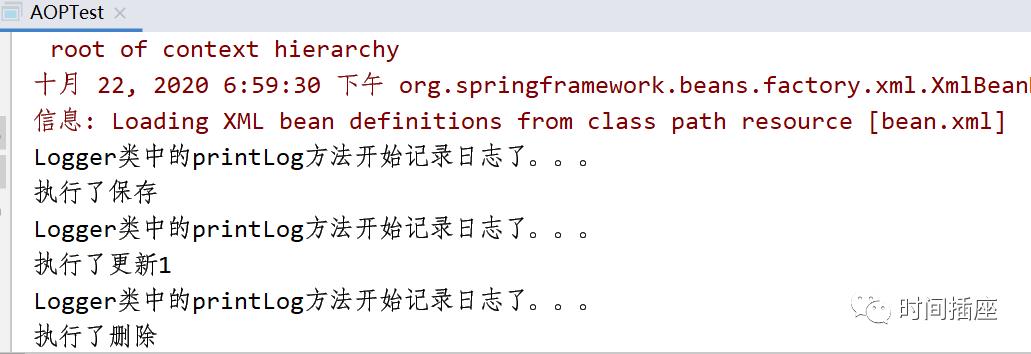AOP相关概念及Spring基于XML的AOP详解
Posted 时间插座
tags:
篇首语:本文由小常识网(cha138.com)小编为大家整理,主要介绍了AOP相关概念及Spring基于XML的AOP详解相关的知识,希望对你有一定的参考价值。
要理解切面编程,就需要先理解什么是切面。用刀把一个西瓜分成两瓣,切开的切口就是切面;炒菜,锅与炉子共同来完成炒菜,锅与炉子就是切面。web层级设计中,web层->网关层->服务层->数据层,每一层之间也是一个切面。编程中,对象与对象之间,方法与方法之间,模块与模块之间都是一个个切面。
什么是AOP?
AOP:全称是 Aspect Oriented Programming 即:面向切面编程。
简单的说它就是把我们程序重复的代码抽取出来,在需要执行的时候,使用动态代理的技术,在不修改源码的基础上,对我们的已有方法进行增强。
AOP优势:
减少重复代码
提高开发效率
维护方便
AOP相关术语:
Joinpoint( 连接点):
所谓连接点是指那些被拦截到的点。在 spring 中,这些点指的是方法,因为 spring 只支持方法类型的连接点。
Pointcut( 切入点):
所谓切入点是指我们要对哪些 Joinpoint 进行拦截的定义。
Advice( 通知/ 增强):
所谓通知是指拦截到 Joinpoint 之后所要做的事情就是通知。
通知的类型:前置通知,后置通知,异常通知,最终通知,环绕通知。
Introduction( 引介):
引介是一种特殊的通知在不修改类代码的前提下, Introduction 可以在运行期为类动态地添加一些方
法或 Field。
Target( 目标对象):
代理的目标对象。
Weaving( 织入):
是指把增强应用到目标对象来创建新的代理对象的过程。
spring 采用动态代理织入,而 AspectJ 采用编译期织入和类装载期织入。
Proxy (代理):
一个类被 AOP 织入增强后,就产生一个结果代理类。
Aspect( 切面):
是切入点和通知(引介)的结合。
基于XML的AOP配置:
pom.xml导入依赖
<packaging>jar</packaging><dependencies><dependency><groupId>org.springframework</groupId><artifactId>spring-context</artifactId><version>5.0.2.RELEASE</version></dependency><!-- 解析切入点表达式--><dependency><groupId>org.aspectj</groupId><artifactId>aspectjweaver</artifactId><version>1.8.7</version></dependency></dependencies>
创建 spring 的配置文件bean.xml并导入约束
<?xml version="1.0" encoding="UTF-8"?><beans xmlns="http://www.springframework.org/schema/beans"xmlns:xsi="http://www.w3.org/2001/XMLSchema-instance"xmlns:aop="http://www.springframework.org/schema/aop"xsi:schemaLocation="http://www.springframework.org/schema/beanshttp://www.springframework.org/schema/beans/spring-beans.xsdhttp://www.springframework.org/schema/aophttp://www.springframework.org/schema/aop/spring-aop.xsd">
spring中基于XML的AOP配置步骤:
1.把通知Bean也交给spring来管理;
2.使用aop:config标签表明开始AOP的配置;
3.使用aop:aspect标签表明配置切面;
属性:
id属性:是给切面提供一个唯一标志
ref属性:是指定通知类bean的id;
4.在aop:aspect标签的内部使用对应的标签来配置通知的类型,我们现在的示例是让printLog方法在切入点方法之前执行:所以是前置通知。
aop:before:表示配置前置通知
method属性:用于指定Logger类中哪个方法是前置通知
pointcut属性:用于指定切入点表达式,该表达式的含义指的是对业务层中哪些方法增强;
切入点表达式的写法:
关键字:execution(表达式)
表达式写法:
访问修饰符 返回值 包名.包名.包名......类名.方法名(参数列表)
标准的表达式写法:
public void com.itheima.service.impl.AccountServiceImpl.saveAccount()
访问修饰符可以省略
void com.itheima.service.impl.AccountServiceImpl.saveAccount()
返回值可以使用通配符,表示任意通配符
* com.itheima.service.impl.AccountServiceImpl.saveAccount()
包名可以使用通配符,表示任意包。但是有几级包,需要写几个*.*
*.*.*.*.AccountServiceImpl.saveAccount()
包名可以使用..表示当前包及其子包
* *..AccountServiceImpl.saveAccount()
类名和方法名都可以使用*来实现通配
* *..*.*()
参数列表:
可以直接写数据类型:
基本类型直接写名称: int
引用类型写包名.类名的方式: java.lang.String
可以使用通配符表示任意类型,但是必须有参数
可以使用..表示有无参数均可,有参数可以是任意类型
全通配写法:
* *..*.*(..)
实际开发中切入点表达式的通常写法:
切到业务层实现类下的所有方法
* com.itheima.service.impl.*.*(..)
案例结构:
/*** 账户的业务层接口*/public interface IAccountService {/*** 模拟保存账户*/void saveAccount();/*** 模拟更新账户* @param i*/void updateAccount(int i);/*** 删除账户* @return*/int deleteAccount();}
/*** 账户的业务层实现类*/public class AccountServiceImpl implements IAccountService {public void saveAccount() {System.out.println("执行了保存");}public void updateAccount(int i) {System.out.println("执行了更新" + i);}public int deleteAccount() {System.out.println("执行了删除");return 0;}}
/*** 用于记录日志的工具类,它里面提供了公共的代码*/public class Logger {/*** 用于打印日志:计划让其在切入点方法执行之前执行(切入点方法就是业务层方法)*/public void printLog(){System.out.println("Logger类中的printLog方法开始记录日志了。。。");}}
<beans xmlns="http://www.springframework.org/schema/beans"xmlns:xsi="http://www.w3.org/2001/XMLSchema-instance"xmlns:aop="http://www.springframework.org/schema/aop"xsi:schemaLocation="http://www.springframework.org/schema/beanshttp://www.springframework.org/schema/beans/spring-beans.xsdhttp://www.springframework.org/schema/aophttp://www.springframework.org/schema/aop/spring-aop.xsd"><!-- 配置spring的ioc,把Service对象配置进来--><bean id="accountService" class="com.itheima.service.impl.AccountServiceImpl"></bean><!-- 配置Logger类--><!-- 日志通知--><bean id="logger" class="com.itheima.utils.Logger"></bean><!-- 配置AOP--><aop:config><!-- 配置切面--><!-- 切面在引用日志通知 ref--><aop:aspect id="logAdvice" ref="logger"><!-- 配置通知的类型,并且建立通知方法和切入点方法的关联--><aop:before method="printLog" pointcut="execution(* com.itheima.service.impl.*.*(..))"></aop:before></aop:aspect></aop:config></beans>
import com.itheima.service.IAccountService;import org.springframework.context.ApplicationContext;import org.springframework.context.support.ClassPathXmlApplicationContext;/*** 测试AOP的配置*/public class AOPTest {public static void main(String[] args) {//1.获取容器ApplicationContext ac = new ClassPathXmlApplicationContext("bean.xml");//2.获取对象IAccountService as = (IAccountService) ac.getBean("accountService");//3.执行方法as.saveAccount();as.updateAccount(1);as.deleteAccount();}}
运行结果:

配置切入点表达式 :
id属性:用于指定表达式的唯一标识。
expression属性:用于指定表达式内容。
此标签写在aop:aspect标签内部只能当前切面使用。
它还可以写在aop:aspect外面,此时就变成了所有切面可用(按约束要求只能放在aop:aspect的前面)。
<aop:pointcut id="pt1" expression="execution(* com.itheima.service.impl.*.*(..))"/>基于XML的四种通知(实现方式一):
<beans xmlns="http://www.springframework.org/schema/beans"xmlns:xsi="http://www.w3.org/2001/XMLSchema-instance"xmlns:aop="http://www.springframework.org/schema/aop"xsi:schemaLocation="http://www.springframework.org/schema/beanshttp://www.springframework.org/schema/beans/spring-beans.xsdhttp://www.springframework.org/schema/aophttp://www.springframework.org/schema/aop/spring-aop.xsd"><!-- 配置spring的ioc,把Service对象配置进来--><bean id="accountService" class="com.itheima.service.impl.AccountServiceImpl"></bean><!-- 配置Logger类--><!-- 日志通知--><bean id="logger" class="com.itheima.utils.Logger"></bean><!-- 配置AOP--><aop:config><!-- 配置切面--><aop:pointcut id="pt1" expression="execution(* com.itheima.service.impl.*.*(..))"/><!-- 切面在引用日志通知 ref--><aop:aspect id="logAdvice" ref="logger"><!--配置前置通知:在切入点方法(业务方法)执行之前执行--><aop:before method="beforePrintLog" pointcut-ref="pt1"></aop:before><!-- 配置后置通知:在切入点方法正常执行之后执行。它和异常通知永远只能执行一个--><aop:after-returning method="afterReturningPrintLog" pointcut-ref="pt1"></aop:after-returning><!--配置异常通知:在切入点方法执行产生异常之后执行。它和后置通知永远只能执行一个--><aop:after-throwing method="afterThrowPrintLog" pointcut-ref="pt1"></aop:after-throwing><!-- 配置最终通知:无论切入点方法是否正常执行它都会在其后面执行--><aop:after method="afterPrintLog" pointcut-ref="pt1"></aop:after></aop:config></beans>
/*** 用于记录日志的工具类,它里面提供了公共的代码*/public class Logger {/*** 前置通知*/public void beforePrintLog(){System.out.println("前置通知Logger类中的beforePrintLog方法开始记录日志了。。。");}/*** 后置通知*/public void afterReturningPrintLog(){System.out.println("后置通知Logger类中的afterPrintLog方法开始记录日志了。。。");}/*** 异常通知*/public void afterThrowPrintLog(){System.out.println("异常通知Logger类中的afterThrowPrintLog方法开始记录日志了。。。");}/*** 最终通知*/public void afterPrintLog(){System.out.println("最终通知Logger类中的afterPrintLog方法开始记录日志了。。。");}
运行结果:

环绕通知(实现方式二):
靠自己编码实现增强方式,而不是靠配置bean.xml
问题:
当我们配置了环绕通知之后,切入点方法没有执行,而通知方法执行了。
分析:
通过对比动态代理中的环绕通知代码,发现动态代理的环绕通知有明确的切入点方法调用,而我们的代码中没有。
解决:
Spring框架为我们提供了一个接口:ProceedingJoinPoint。该接口有一个方法proceed(),此方法就相当于明确调用切入点方法,该接口可以作为环绕通知的方法参数,在程序执行时,spring框架会为我们提供该接口的实现类供我们使用。
spring中的环绕通知:
它是spring框架为我们提供的一种可以在代码中手动控制增强方法何时执行的方式。
<beans xmlns="http://www.springframework.org/schema/beans"xmlns:xsi="http://www.w3.org/2001/XMLSchema-instance"xmlns:aop="http://www.springframework.org/schema/aop"xsi:schemaLocation="http://www.springframework.org/schema/beanshttp://www.springframework.org/schema/beans/spring-beans.xsdhttp://www.springframework.org/schema/aophttp://www.springframework.org/schema/aop/spring-aop.xsd"><!-- 配置spring的ioc,把Service对象配置进来--><bean id="accountService" class="com.itheima.service.impl.AccountServiceImpl"></bean><!-- 配置Logger类--><!-- 日志通知--><bean id="logger" class="com.itheima.utils.Logger"></bean><!-- 配置AOP--><aop:config><!-- 配置切面--><aop:pointcut id="pt1" expression="execution(* com.itheima.service.impl.*.*(..))"/><!-- 切面在引用日志通知 ref--><aop:aspect id="logAdvice" ref="logger"><!-- 配置环绕通知 --><aop:around method="aroundPringLog" pointcut-ref="pt1"></aop:around></aop:aspect></aop:config></beans>
package com.itheima.utils;import org.aspectj.lang.ProceedingJoinPoint;/*** 用于记录日志的工具类,它里面提供了公共的代码*/public class Logger {public Object aroundPringLog(ProceedingJoinPoint pjp){Object rtValue = null; //proceed()的返回值类型为Objecttry {Object[] args = pjp.getArgs();//得到方法执行所需的参数//写在proceed前表示前置通知System.out.println("Logger类中的aroundPringLog方法开始记录日志了。。前置。");rtValue = pjp.proceed(args);//明确调用业务层方法,也叫切入点方法//写在proceed前表示后置通知System.out.println("Logger类中的aroundPringLog方法开始记录日志了。。。后置");return rtValue;}catch (Throwable t){//写在catch表示异常通知System.out.println("Logger类中的aroundPringLog方法开始记录日志了。。。异常");throw new RuntimeException(t);}finally {//写在finally表示最终通知System.out.println("Logger类中的aroundPringLog方法开始记录日志了。。。最终");}}}
import com.itheima.service.IAccountService;import org.springframework.context.ApplicationContext;import org.springframework.context.support.ClassPathXmlApplicationContext;/*** 测试AOP的配置*/public class AOPTest {public static void main(String[] args) {//1.获取容器ApplicationContext ac = new ClassPathXmlApplicationContext("bean.xml");//2.获取对象IAccountService as = (IAccountService) ac.getBean("accountService");//3.执行方法as.saveAccount();}}
运行结果:
以上是关于AOP相关概念及Spring基于XML的AOP详解的主要内容,如果未能解决你的问题,请参考以下文章